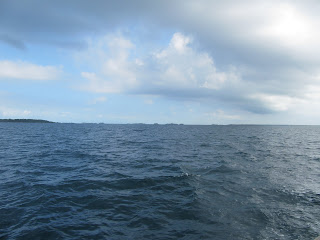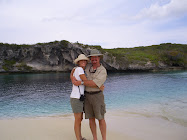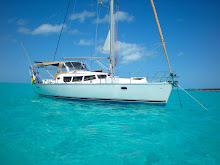 |
| Departing Isla Grande, Colombia |
Departing at a much more civilized hour of 0930 so as to arrive at Isla de Pinos, Panama midday on the 6th, we head out into the Caribbean once again with reefed sails and the motor running. Although during the course of the next 25 hours we will sail without the engine we will, as we do eighty percent of the time, motor sail. Maintaining a heading of 240*T we sail along at 6k watching the grey clouds during the day and the lightening during the night, although the night is nothing like the trip to Santa Marta; we sleep well. The big events for this trip are the logs. Turns out to be a lot of them floating along the stream, we bump them in the night, sometimes they make the boat quiver, most of the time they make Ed jump from his slumber asking his usual “what was that?”. He worries too much.
 |
| Boto at rest, Isle de Pinos |
 |
| it's time to decorate for Christmas |
 |
| our neighbor, "La Luna" |
Originally from the Darie’n Mountains of Panama the Kuna Yala moved to the coast and later to the offshore islands of Panama during the time of the Spanish conquistadors. At the time it is estimated that the Kuna numbered between half and three-quarters of a million people, today the nation has approximately 50,000. Although the Kuna live a simple life of fishing and agriculture it was in 1925 when after many years of suffering violence at the hands of outsiders they revolted against the Panamanian government and with the aid of the United States managed to secure an autonomous rule for themselves, according to their laws the islands of the San Blas belong to all Kunas, especially the coconuts.
 |
| Kuna restaurant for lunch |
 |
| surveying "Dog Island" |
 |
| Village of Achutupu |
The San Blas Islands are scattered some 120 miles along the coast of southeast Panama many sporting nothing more than a single thatch roofed lean-to offering protection to those tending to the coconuts. While other islands are literally bursting at the sides with buildings and people. We are off at a reasonable hour on Friday December 9th to head to the next little group of these islands. Some 20nm from Pinos is Achutupu (Dog Island) where we will anchor in 40 feet behind a few tinny islands and the larger Achutupu. On our trip from Pinos we will sail along the edge of the deep water, where the ledge drops off to 100 feet and then more with rain and 4-6 foot swell. Accompanying us on this trip are a number of Kuna canoes out in the weather and the swell fishing, by hand line. Some of these canoes sport a single sail while the majority are propelled by paddles and sweat. The canoes themselves are carved from a single tree and in spite of their diminutive size are very seaworthy.
Running along inside the reef protected from the seas swell one can travel most of the length of the San Blas islands, with water depths either side of twenty feet. It reminds us of the trip along the ICW in the U.S.. Much like the ICW there are areas of little water where a boat can and will run aground. As we prepare to depart Achutupu we debate the merits of running up the inside (a shorter distance) and going outside (more swell and a longer trip). The outside wins as the clarity/visibility of the water along the inside route has been reduced to a muddy nil do to the recent rains flushing much and mire down the rivers into the ocean. As we wait an additional day to depart we watch as other boats run aground, several times. We even go to the assistance with our dink to help push off all the while the Kuna gather to watch the unplanned entertainment pointing out that the water level is very shallow.
 |
| beach time at Tupile |
After ten days in the more remote eastern San Blas we are ready for a taste of civilization so we are off to Rio Diablo (Nargana) and Corazon de Jesus. A bit longer trip of 30nm we end up anchored in 20 feet at 09*26.7N 78*34.8W. Here at Nargana there are several small tiendas along with a couple of restaurants. The village also has a good sized school which offers FREE WiFi! In addition to fresh veggies we load up on chicken, well one chicken. That’s one whole chicken complete with beak; at least it has been plucked. We take our pollo back to Boto where we do the butchering into dinner sized morsels.
For those in need of fuel Nargana had both gasoline and diesel (most of the time). Visit Paco next to Nillie’s Café, he is the third dock on the left. Diesel is in 15 gallon drums and is transferred via siphon to your jerry cans, so bring a funnel with a filter. While there was little water in the fuel there was a good amount of sediment.
Although Panama and the San Blas are new to us there have been many here before us. As with many of the islands we have visited we are able to benefit their experiences by staying in touch on the radio. In the San Blas there is a daily SSB net on 8.107.0. On this net you can catch up with old friends and find the best place to grab a lobster dinner.
 |
| beach time at Green Island |
 |
| a slice of Paradise |
An entire 5nm from our anchorage in Nargana we drop the hook inside the shelter of Green Island, here after a couple of weeks restricted to the boat Chula will finally get some beach time. After the relative hustle and bustle of Nargana this little group of islands (9*28.7N 78*38.1W) offers a return to solitude, oh and a lobster dinner.
 |
| Dinner! |
 |
| which one's mine? |
What does one do in paradise? Clean the boat, give the dog a haircut, collect rainwater, laundry, baking, and ice the cervasa, the usual.
Well it’s getting on towards the end of 2011, our Christmas shopping is done and we’ll be spending the holiday in the Hollandes Cays before heading to the Lemon Cays to ring in the New Year. For now we are content to enjoy the sea breeze and read a few books. Until next time (Hey we’re almost current with this thing!).


No comments:
Post a Comment